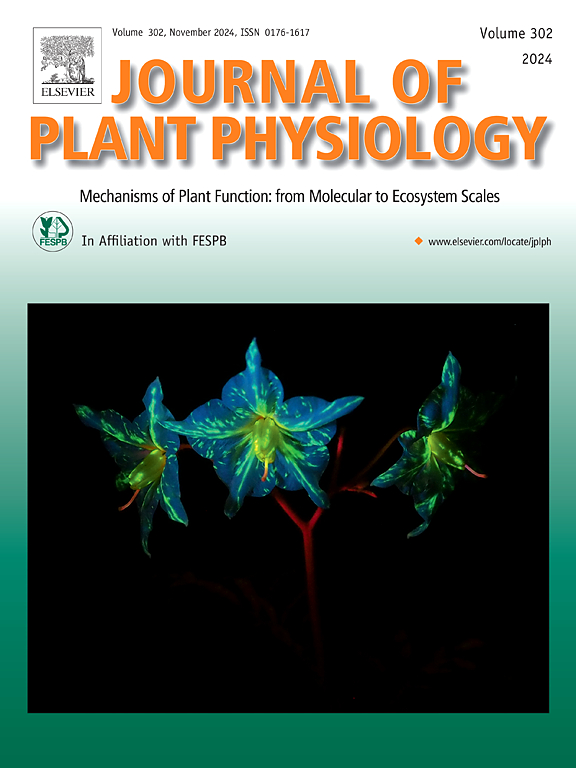Phospholipid signaling in plant growth and development: Insights, biotechnological implications and future directions
IF 4.1
3区 生物学
Q1 PLANT SCIENCES
引用次数: 0
Abstract
Phospholipid signaling is essential for plant growth and development, orchestrating cellular membrane dynamics and regulating physiological processes critical for environmental adaptation. Phosphatidic acid (PA) plays diverse roles in key plant functions, including facilitating pollen tube growth, protecting against H2O2-induced cell death, and modulating actin cytoskeleton polymerization. Additionally, PA influences abscisic acid (ABA) signaling, impacting ionic flux, stomatal movement, and superoxide production. Phospholipase D (PLD) emerges as a crucial regulator, potentially linking and orchestrating microtubule reorganization. Saturated fatty acids, produced through phospholipase A (PLA) activity, also regulate various cellular processes. In Arabidopsis thaliana, Defender Against Apoptotic Death1 (DAD1), a plastidic PC-PLA1, supports jasmonic acid (JA) biosynthesis, which is essential for pollen maturation and flower development. Phospholipid signaling significantly influences stomatal function, with phospholipases modulating stomatal closure. This signaling pathway also plays a critical role in root development, where phosphocholine (PCho) and PA regulate root growth and tip growth of root hairs. This review highlights the pivotal role of phospholipid signaling pathways in coordinating plant growth, development, and responses to environmental cues. It explores the roles of PLD and PA in signal transduction and membrane degradation, particularly in seed aging. Additionally, it discusses the biotechnological applications of plant lipids, including genetic engineering for nutritional enhancement and biofuel production. Despite recent advancements, challenges such as low yield remain obstacles to the widespread adoption of biodiesel technology.
磷脂信号在植物生长和发育:见解,生物技术的影响和未来的方向
磷脂信号在植物生长发育、调控细胞膜动力学和调节对环境适应至关重要的生理过程中发挥着重要作用。磷脂酸(Phosphatidic acid, PA)在植物的关键功能中发挥着多种作用,包括促进花粉管生长、保护h2o2诱导的细胞死亡、调节肌动蛋白细胞骨架聚合等。此外,PA影响脱落酸(ABA)信号,影响离子通量、气孔运动和超氧化物的产生。磷脂酶D (PLD)作为一个关键的调节因子,可能连接和协调微管重组。饱和脂肪酸,通过磷脂酶A (PLA)活性产生,也调节各种细胞过程。拟南芥(Arabidopsis thaliana)抗凋亡死亡防御蛋白1 (DAD1)是一种可塑性的PC-PLA1,它支持茉莉酸(jasmonic acid, JA)的生物合成,而茉莉酸是花粉成熟和花朵发育所必需的。磷脂信号显著影响气孔功能,磷脂酶调节气孔关闭。该信号通路在根发育中也起关键作用,其中磷酸胆碱(PCho)和PA调节根生长和根毛尖端生长。这篇综述强调了磷脂信号通路在协调植物生长、发育和对环境信号的反应中的关键作用。它探讨了PLD和PA在信号转导和膜降解中的作用,特别是在种子老化中。此外,还讨论了植物脂质的生物技术应用,包括用于营养增强和生物燃料生产的基因工程。尽管最近取得了一些进展,但低产量等挑战仍然是生物柴油技术广泛采用的障碍。
本文章由计算机程序翻译,如有差异,请以英文原文为准。
求助全文
约1分钟内获得全文
求助全文
来源期刊

Journal of plant physiology
生物-植物科学
CiteScore
7.20
自引率
4.70%
发文量
196
审稿时长
32 days
期刊介绍:
The Journal of Plant Physiology is a broad-spectrum journal that welcomes high-quality submissions in all major areas of plant physiology, including plant biochemistry, functional biotechnology, computational and synthetic plant biology, growth and development, photosynthesis and respiration, transport and translocation, plant-microbe interactions, biotic and abiotic stress. Studies are welcome at all levels of integration ranging from molecules and cells to organisms and their environments and are expected to use state-of-the-art methodologies. Pure gene expression studies are not within the focus of our journal. To be considered for publication, papers must significantly contribute to the mechanistic understanding of physiological processes, and not be merely descriptive, or confirmatory of previous results. We encourage the submission of papers that explore the physiology of non-model as well as accepted model species and those that bridge basic and applied research. For instance, studies on agricultural plants that show new physiological mechanisms to improve agricultural efficiency are welcome. Studies performed under uncontrolled situations (e.g. field conditions) not providing mechanistic insight will not be considered for publication.
The Journal of Plant Physiology publishes several types of articles: Original Research Articles, Reviews, Perspectives Articles, and Short Communications. Reviews and Perspectives will be solicited by the Editors; unsolicited reviews are also welcome but only from authors with a strong track record in the field of the review. Original research papers comprise the majority of published contributions.
 求助内容:
求助内容: 应助结果提醒方式:
应助结果提醒方式:


